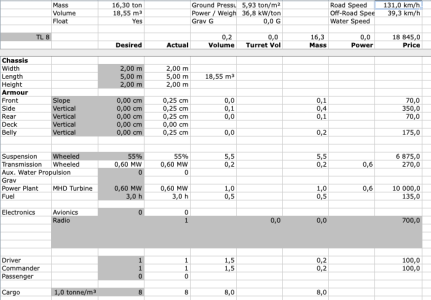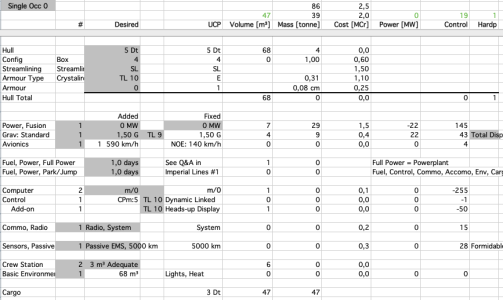So, back to the main thread: if 1000kg/m^3 is the density of water, then a vessel with a mass of 1000kg/m^3 will float roughly just with the top edge on the surface of the water and nothing above the water. Most things I design using Mongoose book 6 Military Vehicles come in between 200 and 600kg/m^3 depending on how heavily I armor them. Even the heavy bulldozer is ~660kg/m^3, and nearly half that mass is armor. (In our Traveller game we wound up wanting an armored vehicle for one mission; it was way past the law level to get one, so we rented a bulldozer and spent some time modifying it into a killdozer, and small arms ammo made pretty sparks and did not hurt us. Great fun was had except by the gangers we'd been hired to take out, and the owners of the building they'd fortified. It looked suicidal to try and go in through any of the entrances the gangers guarded, so we went in through the wall.)
Is it the case in CT that it's hard to design vehicles that exceed 1000kg/m^3? I can do it, but the vehicles are so weighted down they barely move. In my recent attempt at a light cargo speeder with about 1/3 the space alloocated to cargo, I managed to get the cargo up to 3000kg/m^3 or 18,000kg for a 6 m^3 cargo space. The vehicle was slowed to 62kph top speed/46kph cruise.
For a wheeled vehicle, I need to crank the cargo up way past where the vehicle only runs on special roads to get to 1000kg/m^3, and the top speed has dropped to 31kph, which I guess is reasonable for carrying that much cargo, but it doesn't seem like this is an area that is typically used by anyone? I guess if a car runs off a bridge and into the water, it doesn't sink until it fills up with water at least enough to make the overall density over 1000kg/m^3? My experience with cars in the water is strictly limited to television, and I have no faith that Hollywood tries to get the physics right.
Also, I have discovered that putting 400kg in the trunk of a passenger car-type ground vehicle drops the top speed by 1/3 (186 kph to 112 kph) per Book 6. I have moved and packed far more than 400kg in my car in RL, and it was a bit slow, but not anywhere near that much slower.
Am I doing all this wrong or what? It feels broken.


